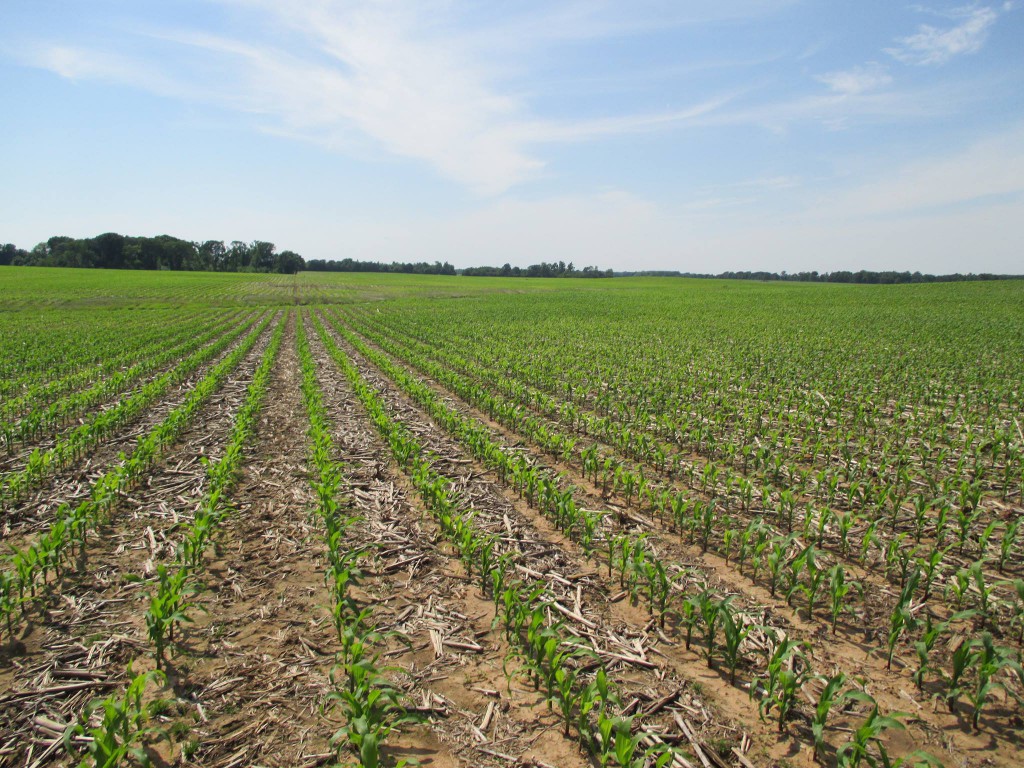By Ross Greene, Nick Shay, Sarah Beth Thompson, and Wesley Porter
We are quickly approaching the time of year (or may already be in it) when we need to consider how to finalize our irrigation management on our corn crop. I have received a few calls and seen pictures of the ends of corn ears tracking the milk line. I would say by the time this article is posted there are many corn fields that should have already terminated irrigation.
The official irrigation termination is black layer and this article is going to step you through that process.

The corn in this picture has reached approximately half or 50% milk line. It is tough to fully estimate how quickly the corn will dry down, as that is related to weather conditions, rainfall, and irrigation applications. The lower the humidity, the faster the kernels will dry down. If you stop irrigating too soon, the kernels will dry too rapidly without final filling, and you will incur yield reductions. Thus, as we approach the dent stage, it is critical that you start monitoring the milk line, the weather, and the soil moisture in your corn fields.
To put it into time perspective, corn will enter the dent stage approximately 31-33 days after silking, and roughly a week after you see the kernels denting, a white milk line will form. This line marks the transition from milky liquid to solid starch inside the kernel. The water demand does decline during this stage; however, grain fill is still occurring and must be supported with water. Water will continue to enter the kernels until you see the black layer form as shown below on the kernel to the right.

Once you start to notice the black layer forming, you should:
- Pull 6 to 8 ears from average areas of the field (not the edge of the field or near field roads).
- Break the ears in half and examine the milk line on the cross section of the kernels.
- When the milk line has dropped to around 50-75% you should evaluate the soil moisture, near-term forecast and make a final decision on irrigation. If you have soil moisture near field capacity, have just irrigated, it just rained, or there is guaranteed rain predicted in the next few days you can most likely terminate irrigation. If none of these are true you should apply an additional irrigation event to prevent yield loss. Depending on milk layer movement, you may need additional irrigation if it remains hot and dry prior to black layer.
If you experienced drought or issues at the end of the season or stopped irrigating too early, the chart below provides some estimated yield losses associated with lack of moisture during the end of the season.
Estimated Field Corn Yield and Revenue Loss at Varying Irrigation Termination Intervals
| Milk Line at Irrigation Termination | Estimated Yield Loss | Bushel Loss (220 bu/ac potential) | Revenue Loss ($5.00/bu) |
| At Dent Stage (0% milk line) | 15–20% | 33–44 bu/ac | $165–$220 |
| 25% Milk Line | 10–15% | 22–33 bu/ac | $110–$165 |
| 50% Milk Line | 5–10% | 11–22 bu/ac | $55–$110 |
| 75% Milk Line | <5% | 0–11 bu/ac | $0–$55 |
| Black Layer (100% milk line) | 0% | 0 bu/ac | $0 |
It can be hard to make the final decision on irrigation termination, but as this article has explained, it is a very important decision.
An additional point is that irrigation after black layer will not be utilized by the plant and will be wasted water and profit. Thus, once you reach black layer, it is time to terminate irrigation on the corn.
Final Considerations
As the end of the season approaches, ensure that you are monitoring the current soil moisture, weather conditions, and milk line on the ears. You should continue to irrigate through the R5 stage and consider termination once 75% milk line is reached and soil moisture conditions are favorable.
As always, if you have further questions about irrigation termination on corn, reach out to your local UGA County Extension Agent.
